
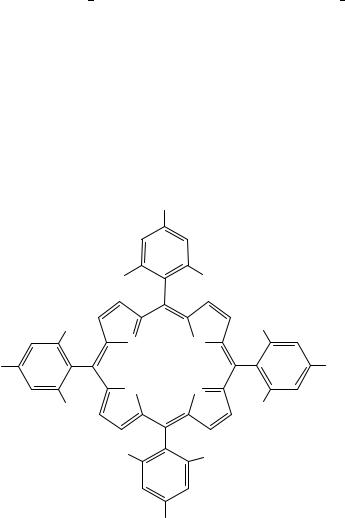
20. Oxidation of dienes and polyenes |
899 |
iodosobenzene, hypochlorite and many others are thought to form highly active intermediate manganese(IV) or more probably manganese(V) oxo intermediates, which can easily react with alkenes to form epoxides in high yields. Turning first to the work with metalloporphyrins, the oxidation of limonene (2) led to regioselective epoxidation at the endocyclic position. Endocyclic/exocyclic ratios varied from 7:153 to 19.6:154 for the manganese and iron porphyrins, respectively. Similar preferred endocyclic oxidation was observed for 4-vinylcyclohexene. In a similar iron-cyclam catalyzed reaction, somewhat lower regioselectivities were observed55. In the reaction of 2-methyl-1,3-butadiene (isoprene), there was also a preference, though significantly lower, for epoxidation at the more substituted double bond53. The oxidation of the trimethylsilylated derivative of geraniol (3) yielded the 6,7-epoxygeranyl OSiMe3 and only traces of the 2,3-epoxygeranyl OSiMe3 compound53. The reactivity of cis vs trans olefins is also of importance. Oxidation of cis, trans, trans-1,5,9-cyclododecatriene (25) showed little preference for either geometry in nonsterically hindered porphyrin ligands although cis-stilbene is much more reactive than trans-stilbene54,56. However, using a more sterically crowded porphyrin ligand, very significant cis/trans regioselectivity was observed. The synthetic manipulation of the porphyrin ligand was further used in comparison of epoxidation of dienes with manganese porphyrins. As steric crowding at the manganese center was increased by use of tetraphenyl- < tetramesityl- < tetra(triphenyl)phenyl porphyrin ligands (43), R D H, Me, Ph, respectively, the natural tendency towards epoxidation at the more substituted double bond could be inverted57. Dramatic effects were observed for 1,4- and 1,3-hexadiene, 4-vinylcyclohexene and limonene (2). Another approach to obtain regioselectivity in a porphyrin-mediated epoxidation was to prepare a vesicular assembly and positioning
R
R |
R |
R |
R |
N |
HN |
R |
R |
NH |
N |
R |
R |
R |
R |
|
R
(43)
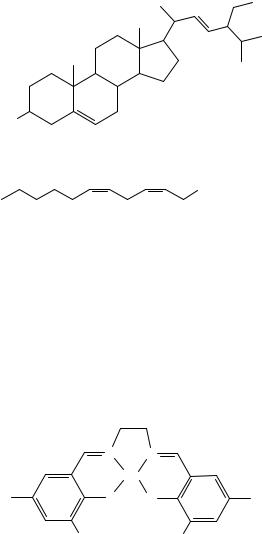
900 |
Ronny Neumann and Alexander M. Khenkin |
the metal active site in the center of the lipid bilayer58. Then using the hydrophobic/hydrophilic orientation of a substrate within such a biomimetic membrane, regioselectivity of epoxidation of selected substrates such as steroids and fatty acids could be controlled. In this way the normal epoxidation of stigmasterol (44) at the 5-double bond in homogeneous solution was reversed to selective epoxidation in the side chain59. Similarly, the epoxidation of the 12-double bond was preferred over the 9 double bond in linoleic acid (45), otherwise equally reactive in homogeneous solution.
HO
(44)
(CH2 )6 COOH
(45)
The regioselectivity of epoxidation of 1,3-conjugated dienes using manganese salen complexes 46 (R D H or t-Bu) was compared to that using the mangenese porphyrins60. Similar regioselectivities were found in four different dienes (isoprene, 2,4-dimethyl-1,3- pentadiene, 1,3-hexadiene and 1,4-diphenyl-1,3-butadiene). A very significant stride was also made recently in the use of a chiral Mn(salen) compound (47) for asymmetric catalytic epoxidation of non-functionalized alkenes61. This method utilizes steric control in the approach of the prochiral double bond to the metal-oxo site, forcing preferred epoxidation at one face of the double bond and therefore formation of epoxides in significant enantiomeric excesses. Jacobsen and his coworkers found early on that in the epoxidation of 1,3-cyclohexadiene and the tert-butyl ester of 2,4-hexadienoic acid enantiomeric excesses of up to ca 60% could be obtained62. In a later and much more complete study63
NN
Mn
OO
R R
(46)
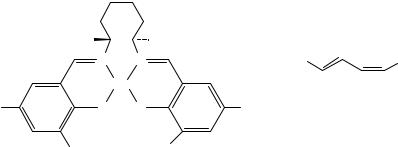
20. Oxidation of dienes and polyenes |
901 |
|
H |
|
|
|
H |
R1 |
|
R2 |
|
|
|
|
|
||||
|
N |
|
|
N |
|
|
||
|
|
|
Mn |
|
|
|
|
|
t-Bu |
O |
|
|
O |
Bu-t |
R1 |
= COOEt, R2 = n-Hex |
|
|
|
|
|
|
|
R1 |
= n-Hex, R2 = Me |
|
|
t-Bu |
|
|
|
t-Bu |
R1 |
= OH, R2 |
= n-Hex |
|
|
|
|
|
|
|
||
|
|
|
|
|
|
|
|
|
|
|
(47) |
|
|
|
(48) |
|
|
on a series of E, Z-conjugated dienes 48, they found that epoxidation at the Z double bond was much preferred. E-Epoxides were formed in excess over the Z-isomers although ratios varied significantly with no apparent reason. Enantioselectivities were moderate to high. Other substrates such as 3-methylenecyclohexene, 1,3-cyclohexadiene and 1,3- cycloheptatriene were also epoxidized with high enantioselectivities64. It is important to note at the conclusion of this section that both the manganese porphyrins and salens react preferably at cis vs trans double bonds in contrast to what was found for permanganate and osmium tetraoxide. In this sense, these former compounds react in a manner similar to the peroxo compounds to be discussed below.
E. Miscellaneous
Selenium dioxide is also an oxygen donor to alkenes. In this case, however, the initial reaction of the double bond is with the selenium center followed by two pericyclic steps. After hydrolysis of the organo-selenium intermediate, the result is a hydroxylation at the allylic carbon position65. Thus, limonene (2) yields racemic p-mentha-1,8(9)-dien-4-ol66. The high toxicity of selenium intermediates and prevalence of many rearrangements has limited the widespread use of the reagent in synthesis.
III. OXIDATION WITH PEROXO COMPOUNDS
The susceptibility of a nucleophilic double bond to an electrophilic oxygen found in peroxo compounds to yield epoxides as products is a very common reaction that was first discovered by Prileschajew at the beginning of the century67. For much of this period the epoxidation reaction had been carried out using organic peracids as the epoxidizing agent. Much of the early research has been detailed in a very extensive and encompassing review68 and later on in a book by Swern69. In the earliest years, epoxidation reactions were generally carried out using peracetic, performic, perbenzoic and perphthalic acids, although often the reaction conditions were such that the epoxide was not isolated as primary product. Usually the epoxide would react further with the acid to form glycol monoesters or with water to form diols. Later on, greater control and understanding of the reaction conditions allowed preparation of epoxides in higher yields. The oxygen transfer mechanism is generally considered to be concerted as first proposed by Bartlett (equation 9)70. The epoxidation of dienes as a distinct class of compounds with peracids has not been specifically reviewed, but many examples have been given in the early manuscripts68,69.
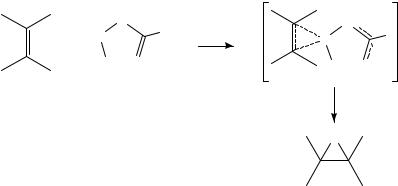
902 |
|
Ronny Neumann and Alexander M. Khenkin |
|
|
|
|
O |
R |
O |
|
|
O |
R |
|
|
+ |
O |
||
|
|
|
|
|
|
|
H O |
H |
O |
(9)
O
+ RCOOH
Although the use of peracids in alkene oxidation is simple, it has several drawbacks, especially in large-scale and industrial situations. As indicated above reaction control vis a vis selectivity can be problematic; however, additionally and perhaps more seriously, peracids are dangerous and explosive compounds which introduce stringent safety considerations when carrying out such reactions71. One possible remedy that is being explored is the use of safer peroxygen compounds. Another possible approach in remediation of this concern is to use alkylhydroperoxides and hydrogen peroxide as oxidants. These compounds are significantly safer and practically inert to double bonds. Their use, however, requires catalytic activation which is generally achieved by use of highvalent (d0) transition metals with high Lewis acidity and low oxidation potentials. Most commonly used are TiIV, VV, WVI, MoVI72 and, more recently, ReVII compounds73. In the activation process it is commonly accepted that a M OOH peroxo intermediate (sometimes termed an inorganic peracid) is formed which is the real epoxidizing agent. Oxygen transfer takes place by a heterolytic cleavage of the O O bond in a manner similar to peracid oxidation. Thus, reagents prepared by mixing metal oxides such as WO3, V2O5 and MoO3 with hydrogen peroxide yield what were originally termed Milas reagents74. These original reagents are poor epoxidizing agents and have not been realized at large scales. However, much recent research is being aimed at improving catalytic hydrogen peroxide activation due to its great perceived ecological and economic advantages. Similarly, there have been considerable efforts in the activation of alkylhydroperoxides, most prominently t-BuOOH. This activation was first realized by Hawkins in 195075 and since has been investigated by many groups. As in the case of organic peracids, there has been no systematic review on the catalytic oxidation of dienes with hydroperoxides.
A. Oxidation with Organic Peracids
The most widely accepted method for epoxidation of alkenes remains oxidation with organic peracids. The early work (up to 1970) in this field shows that a large number of dienes and polyenes were oxidized in this manner69. The most commonly used peracids are peracetic, monoperphthalic and perbenzoic acids which are most dominant in industrial applications. On the other hand, in laboratory procedures m-chloroperbenzoic acid, MCPBA, is often used, with trifluoroperacetic acid cited in more difficult transformations. Recently, the transportation of m-chloroperbenzoic acid has been restricted and the use of other peroxygen agents has been gaining acceptance as a general alternative. Among the substrate types epoxidized it would be especially worthy to point out polyunsaturated
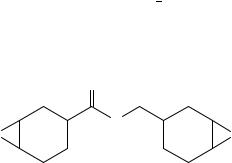
20. Oxidation of dienes and polyenes |
903 |
steroids, fatty acids, terpenes and diesters as well as many simpler diand poly-ene hydrocarbons. The easiest way to summarize the vast pre-1970 literature (over 600 substrates) would be to note the following general conclusions which may serve as a guideline for reactivity in polyfunctionalized compounds. First and foremost, reactions are most strongly affected by the nucleophilicity of the double bond. Therefore, the higher the alkyl substitution at the double bond the higher the reactivity. On the other hand, the presence of electron-withdrawing groups such as carbonyl, carboxylic acids and esters strongly decreases the likelihood of reaction at proximate double bonds. Furthermore, cis-alkenes are more reactive than trans-alkenes, strained double bonds are more reactive than alkenes without strain, cycloalkenes react more easily than dialkyl substituted alkenes and aryl substituents have little effect. Finally, in conjugated dienes, the epoxidation of the second double bond is slower than the epoxidation at the first double bond. Using these guidelines, the expected regioselectivity in a diene epoxidation can be easily determined. In addition, almost without exception, the epoxidation is stereospecific, i.e. cis-double bonds yield cis- epoxides whereas trans-double bonds yield trans-epoxides76. In certain cases neighboring groups may effect direction of the peracid attack at the double bond by steric interaction.
As the oxidation of alkenes with organic peracids is so prevalent, little has been researched over the past two decades at an academic level, especially as concerns epoxidation of diand poly-enes. It is important, however, to point out that organic peracids have, despite safety considerations, been applied in a number of industrial applications77. As concerns polyunsaturated substrates, the most important are the epoxidized vegetable oils (naturally occurring mixtures of unsaturated triglycerides) which are important stabilizers and plasticizers for PVC. Synthetic polymers such as polyisoprenes and polybutadiene containing various percentages of 1,4-cis, 1,4-trans and 1,2-vinyl olefinic units are available which can be epoxidized easily to a level of 6 8% oxirane oxygen. More recently natural rubber has been epoxidized to form a new polymer, epoxidized natural rubber ENR. Both types of the epoxidized polymers may compete with natural rubber in non-tire applications. An interesting monomeric diepoxide is 49, which is both a thermosetting and UV curable cross-linking agent used in the electronics industry.
O
O
O O
(49)
B. New Peroxygen Reagents
Safety considerations concerning the organic peracids described above have led to a search for possible new peroxygen agents with reduced hazard in their use. Despite this trend MCPBA is still often used in the laboratory. For example, one may note its use in the triepoxidation of barrelene78. Some recently developed organic peroxygen compounds include magnesium monoperoxyphthalate hexahydrate, MMPP (50), DABCO- di-N-oxide-di-perhydrate (51) and urea hydrogen peroxide, UHP (52). The oxidation of 1,2-dimethylcyclohexa-1,4-diene (53) and 4,7-dihydroindane (54) with MMPP79 proceeds in an identical manner to that with MCPBA80, i.e. epoxidation at the more electron-rich double bond is preferred. Similar preference for epoxidation at the more substituted double bond was observed in the reaction of 55 carried as one of the stages in the synthesis of the quinone antibiotic frenilicin81.
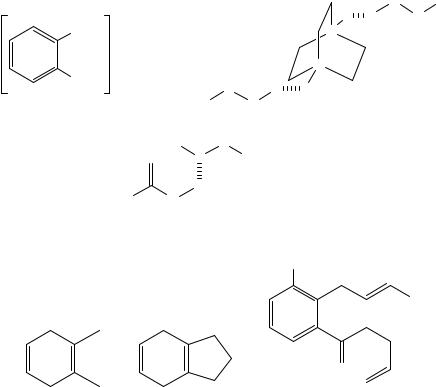
904 Ronny Neumann and Alexander M. Khenkin
|
|
|
|
O |
H |
|
|
|
|
O H |
O |
CO3 H |
|
|
N |
|
|
|
2 + . |
6H2 O |
|
|
|
|
Mg |
|
N |
|
|
|
− |
|
|
|
|
CO2 |
|
O |
H O |
|
|
|
2 |
|
|
||
|
|
H |
|
O |
|
(50) |
|
|
|
(51) |
|
|
|
H |
O |
|
|
|
O |
O |
|
H |
|
|
|
H |
|
|
|
|
H2 N |
N |
|
|
|
|
|
H |
|
|
|
|
|
(52) |
|
|
|
OMe
Pr
O
(53) |
(54) |
(55) |
Epoxidation of limonene (2) with both MMPP and UHP proceeded preferentially at the endocyclic double bond with a 4:1 ratio of regioisomers being observed82. The presence of electron-withdrawing groups also has in general the predictable effect. Therefore, geranyl acetate (3 with OH replaced by OAc) is epoxidized mostly at the 6,7-double bond with both UHP and MCPBA83. Notably, this selectivity can be reversed by using an emulsion technique where the more hydrophobic 6,7-double bond is kept from the waterdissolved oxidant in the hydrocarbon or oil phase. Selectivity of 93% to the 2,3-epoxide was obtained84. Normal regioselectivity was obtained in the epoxidation of the substituted diene esters 56 and 57 with MMPP. The former yielded the ˛-epoxide, 58, exclusively vs 3:1 mixture of ˛ versus ˇ-epoxide with 3,5-dinitroperbenzoic acid85, whereas the latter gave, upon acid-catalyzed cyclization, a tetrahydrofuran intermediate 59 as a key step in the total synthesis of (C)-altholactone (equation 10)86. Worth noting also is the good diastereofacial selectivity obtained with MMPP, 3.5:1, in favor of the ˇ-face vs poor selectivity with MCPBA. In the oxidation of ˛-ionone (60) with UHP, the endocyclic double bond was exclusively epoxidized78. This selectivity could be inverted by using basic conditions where a nucleophilic HOO species is formed and is known to attack the more electrophilic double bond87.
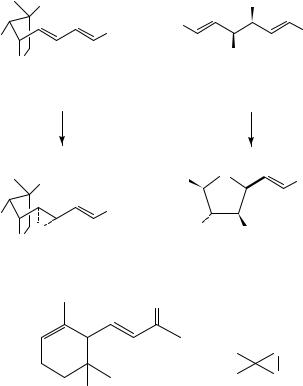
20. Oxidation of dienes and polyenes |
905 |
||||
OH |
|
|
|
OH |
|
|
CO2 Et |
Ph |
|
|
CO2 Et |
HO |
|
|
|
||
|
|
|
|
||
|
|
|
|
|
|
O |
|
|
OH |
|
|
|
|
|
|
|
|
(56) |
|
|
|
(57) |
|
|
|
|
|
|
(10) |
OH |
|
Ph |
O |
|
CO2 Et |
|
|
|
|||
HO |
CO2 Et |
|
|
|
|
|
HO |
|
|
|
|
O |
|
|
OH |
|
|
O |
|
|
|
|
|
(58) |
|
|
(59) |
|
|
|
|
O |
|
|
|
|
|
|
H3 C |
|
O |
|
|
|
H3 C |
|
O |
|
(60) |
|
|
(61) |
|
Another interesting new class of peroxygen compounds relevant to the oxidation of alkenes are the dioxiranes, especially the dimethyldioxirane (61) only recently isolated88. Although almost no specific research has been carried out in diene oxidation, research into the oxidation of various alkenes has revealed that the dioxirane reagent is less sensitive to substitution effects than peracids, thereby leading to greater reactivity with less nucleophilic substrates89. One important example worth pointing out is the epoxidation of allenes, 62, to the corresponding diepoxides, 6390,91. An interesting comparison may be made when investigating similar oxidations with MCPBA92. In certain cases formation of a monoepoxide may be followed by a cyclization reaction93. Another highlight in the use of dimethyldioxirane is the epoxidation of aflatoxin B1 to form the 8,9 epoxide, 64, a well-known carcinogen which could not be prepared by other methods94.
Inorganic peroxygen compounds have also been mentioned as possible organic peracid substitutes. Most noteworthy are potassium monopersulfate, oxone, as a triple salt 2KHSO5 Ð KHSO4 Ð K2SO4, sodium perborate and sodium percarbonate. The direct use of oxone has been limited because of the high acidity of this reagent, although it is most often used in the presence of ketones to form dioxiranes as discussed above95. 4- Vinylcyclohexene was predominately oxidized at the endocyclic double bond with this
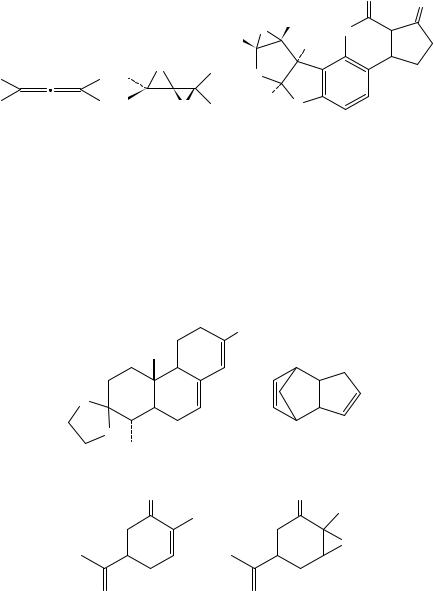
906 |
Ronny Neumann and Alexander M. Khenkin |
|
|
|
|
O |
O |
|
|
|
|
|
O |
H |
|
|
O |
|
|
|
H |
H |
|
|
|
|
|
|
O |
|
|
|
O |
|
|
|
H |
O |
|
|
O |
|
|
(62) |
(63) |
(64) |
|
reagent96. In a somewhat unusual reaction oxone gave higher yields than MCPBA in
the oxidation |
of the dienyl ethers 65 (R |
D |
Me, Et), a key step in the total synthesis |
||||||||
97 |
|
|
|
|
is active in diene epoxidation at |
||||||
of |
bruceantin |
|
. A 2-nitrobenzenesulfonyl peroxide |
||||||||
|
30 ° |
|
|
98 |
|
|
|
perborate has been used to epoxidize |
|||
|
|
C with normal regioselectivity |
. Sodium |
|
99 |
. Oxidation of the ˛, ˇ-enone 67 |
|||||
the tricyclic diene 66 at a 50% yield to the diepoxide |
|
||||||||||
to 68 at high yields would seem to indicate that the perborate has a reactivity profile more similar to basic hydrogen peroxide100. In summary, in recent years we have seen the advent of new peroxygen reagents, developed to overcome inherent safety problems in the use of organic peracids. Selectivity profiles are often near to those found for the peracids.
OR
O
O
(65) |
(66) |
O |
O |
O
(67) |
(68) |
C. Catalytic Activation of Hydroperoxides
As stated above, one of the alternatives to using organic peracids for the oxidation of alkenes is the use of hydroperoxides72. Since the latter are practically inert to double

20. Oxidation of dienes and polyenes |
907 |
bonds, it is necessary to activate the hydroperoxide with high-valent transition metals. Use of main group oxides such as selenium dioxide has also been documented. The majority of research has been in the use of tert-butyl hydroperoxide and aqueous hydrogen peroxide. Although the exact mechanism of oxygen transfer is not known for all cases, one may generalize by saying the reaction proceeds by formation of a complex between the metal center and the hydroperoxide forming a so-called ‘inorganic peracid’. The oxygen transfer occurs via heterolysis of the oxygen oxygen bond aided by polarization of electron density to the high-valent metal. As concerns synthetic applications, it is important to point out that as the oxidation potential and Lewis acidity of the metal catalysts increase, the selectivity of the reaction often is decreased, due to homolysis of the hydroperoxide. This leads both to non-productive decomposition of the hydroperoxide and often unwanted side reactions due to the intermediate radical oxygen species formed.
1. Alkyl hydroperoxides
In agreement with the electrophilic nature of the metal-hydroperoxide intermediate, the rate of epoxidation increases with the nucleophilicity of the double bond and therefore closely parallels reactivity of organic peracids. The first in-depth study101 with tert-butylhydroperoxide (TBHP) as oxidant with homogeneous vanadium and molybdenum compounds as catalysts revealed that the latter are more effective than the former by approximately two orders of magnitude. However, in the case of allylic alcohols this trend is reversed (see below). For example, oxidation of limonene102
(2) and 4-vinylcyclohexene96 exclusively yielded the epoxide at the endocyclic double bond with Mo(CO)6 as catalyst. Similarly, 1,5-cyclooctadiene and cis, trans, trans- 1,5,9-cyclododecatriene both yielded monoepoxides with the same catalyst, the latter preferably at the cis-double bond. Conjugated dienes such as 1,3-butadiene and isoprene103 reacted more slowly. The latter reaction was not regioselective. Other molybdenum complexes have also been used104. Early on it was also found that functional groups such as acetates could bring about preferential attack at the double bond from the face of the molecule containing the functional groups, leading to excess formation of stereoisomers, in contrast to what was observed for organic peracids105.
The strong rate acceleration observed in allyl alcohol oxidation with vanadium compounds, usually VO(acac)2, despite the electron-withdrawing effects observed in peracid epoxidation, was attributed to the strong coordination of the alcohol ligands to the metal. This use of VO(acac)2 and TBHP was utilized to selectively epoxidize both geraniol and linalool at the double bond allylic to the alcohol group with very high selectivity, in contrast to what was found with organic peracids106. The principle of preferred oxidation at an allyl alcohol double bond was further utilized almost immediately. Examples include the oxidation of the multifunctionalized alcohol, 69, to the diepoxide, 70, in the synthesis of a juvenile hormone107, and regioselective epoxidation of 71 to 72 (equation 11)108. The reactions are also stereospecific to syn addition. Therefore, the regioselectivity along with the stereospecificity of addition was also used in the epoxidation of 1,5-cyclohexadiene- 4-ol109 and the cyclic dienol, 73, which led to 74 via transannular rearrangement of the initially formed syn-epoxide (equation 12)110. The stereoselectivity of the epoxidation was also applied in the preparation of the antibiotic methyl pseudomonate A111. Homoallylic alcohols can also be epoxidized very effectively112. In compound 75 having both an endocyclic and an exocyclic homoallylic double bond, the former was oxidized much more easily to yield 76 (equation 13)113.
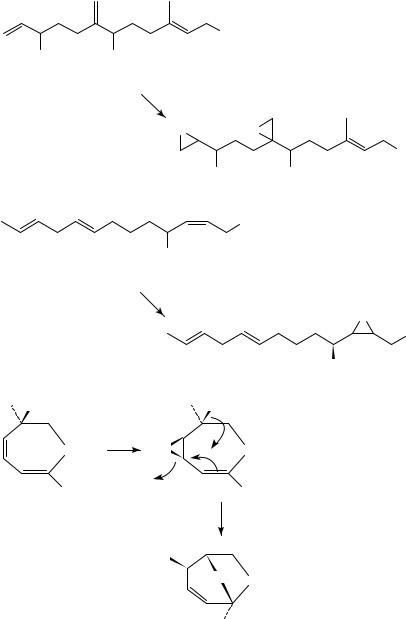
908 |
Ronny Neumann and Alexander M. Khenkin |
OCPh3
OH OH
(69)
O O
OCPh3
OH OH
(70) |
(11) |
OH
OH
(71)
O
OH
OH
(72)
OH |
|
OH |
(CH2 )n |
O |
(CH2 )n |
Me |
|
Me |
(73) |
|
|
(12)
HO
O (CH2 )n
Me
(74)
